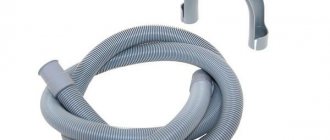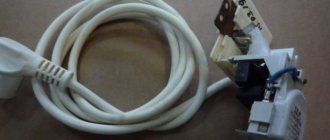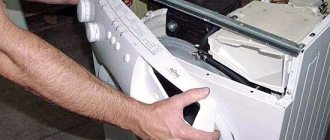In matters of restoring the technical capabilities and performance of household appliances, we are accustomed to relying on service centers. However, not all breakdowns require the intervention of a specialist. Many minor problems can be easily fixed with your own hands.
One typical example is repairing washing machine shock absorbers, which you can do yourself. We will tell you how to dismantle worn parts of the shock absorption system and install new elements. Our recommendations will help you quickly and efficiently restore the operation of your washing machine.
How to identify the exact nature of the breakdown?
Washing equipment sometimes breaks down and becomes unusable for many reasons. If, during the washing and rinsing process, extraneous noise occurs, which is additionally accompanied by vibration, it can be assumed that the shock absorbers and parts of the part have crumbled or failed. However, the same symptoms can also be observed if the bearings in the washing machine have crumbled, or foreign objects have entered the space between the laundry tub and the body. To make sure that the shock absorbers are broken, you should first disconnect the washing machine from the network. After this, you need to open the doors to load laundry, then slightly pull the device towards you and release. If it falls into place without difficulty and extraneous noise, then the dampers are working. The washing machine swaying from side to side will be evidence that the springs have failed.
Rules for selecting spare parts
Each washing machine model has its own design features. Therefore, there are no universal spare parts that fit all washing machines.
When purchasing new shock absorbers, it is advisable to make sure of their quality. When compressed, the part must provide resistance .
If, when compressing, practically no effort is required, such a part is not suitable for installation.
You should not purchase more powerful shock absorbers with the hope that the washing machine will be overloaded. This is a mistaken opinion; this cannot be done, since all elements of the machine (not just dampers) are designed for certain loading parameters specified by the manufacturer.
If you have doubts about choosing a new pair of parts, you can go to the store with the removed ones and ask the seller to pick up similar ones.
Video review on the selection of shock absorbers:
What damage could have happened?
What caused the problem:
- Wear of gaskets due to frequent use.
- Defective parts, improper transportation of the machine.
- The rod that secures the shock absorber is faulty.
Whatever breakdown occurs, it is important to know how to restore the shock absorber in a washing machine with your own hands.
Diagnostics for vertical loading
If shock absorbers or dampers are damaged, a specific noise is heard - knocking during washing, coming from inside. Possible distortions of the housing or strong vibration.
Diagnostics for vertical loading is carried out as follows.
- Press the top of the tank with your hand. If you feel that there is no resistance, and after you remove your hand it continues to swing, then it is time for repairs.
- Watch how the drum rotates. If it’s tight or squeaky, it means the parts are not lubricated at all.
- Disassemble the machine, remove the cover from the back. Press down on the tank again and forcefully lower it down, then quickly release it. If the tank jumps and no longer moves, then the shock absorbers are normal.
These simple diagnostic methods will help you determine whether your washing machine's dampers need repair.
Front loading diagnostics
Diagnosis of a front-loading washing machine occurs in a different way.
- Press firmly on the tank at the top and look at the hatch seal lip. If folds form on it, then repair is needed.
- Be sure to note how much the tank drops as you press.
Normally, when pressing, folds should not appear on the seal and the tank should not sag when it is loaded.
If all these defects are found, the device should be repaired.
Features of work
What are shock absorbers used for? They dampen machine vibrations during operation, so they are located under the tank. When spinning at high speeds, the drum rotates quickly, and the MCA begins to vibrate strongly. If there were no shock-absorbing effect, she would jump in place.
More modern SM models use dampers. Let's see what the differences are between these shock-absorbing parts.
Difference in device
Before replacing shock absorbers in a washing machine, let’s look at their structure:
- cylinder;
- return spring;
- piston with rods;
- gaskets
Now let's move on to the shock absorber damper of the washing machine. The element is the same cylindrical structure, only without springs. In this case, the washing machine tank is suspended on springs. This feature contributes to better vibration damping, which is why it is used everywhere in new models.
DIY repair
Let's find out how to get to the damper. Proceed as follows:
- Let's assume you've already removed the top cover.
- Turn off the water supply and disconnect the inlet hose from the housing. There may be water in it, so prepare a container to drain it in advance.
- Now you need to remove the front panel. To do this, pull out the dispenser tray: press the latch in the center and pull the tray towards you.
- Remove the screws that secure the control panel. Two or three bolts are located behind the tray and on the opposite side.
- Release the plastic latches.
- Take a photo of the location of the wires on the panel and disconnect them or place the panel on top of the CMA body.
- Open the hatch door. Having bent the sealing rubber, use a screwdriver to pry up the metal clamp and remove it.
- Tuck the cuff inside the drum.
- Unscrew the hatch lock bolts (UBL).
- Disconnect the wiring from the locking device and pull it out.
- Unlock the panel latches at the bottom where the drain filter is located and set it aside.
- Unscrew the screws securing the front panel and remove it.
At the bottom of the tank you will notice two dampers. They are usually fastened with plastic rods on top and bolts on the bottom. How to remove the shock absorber from a washing machine:
- Place a nut on the back side of the rod mount to disable the latch.
- Grasp the rod with pliers and pull it towards you.
- Now unscrew the bolt at the bottom.
Some users are wondering: how to check shock absorbers when purchasing? Same as when replacing. Squeeze and unclench the part in your hand: if this is difficult to do, then the product is working properly. If you compress the shock absorber easily, it needs replacement.
Note! Even if only one damper is faulty, both need to be replaced at once.
How can you repair a shock absorber in a washing machine with your own hands? First, pull out the insert that slows down the movement of the rod. If the rod moves easily and quickly, the insert (gasket) is most likely worn out. To replace it:
- Take a 3mm thick belt.
- Measure the length according to the diameter of the hole.
How to repair a shock absorber yourself
To restore the serviceability of the device, you should remove the insert and then check how the rod moves without the gasket. If this manipulation is carried out without any difficulty, then it follows that the problem lies in the worn insert. Correcting the situation consists of the following steps:
- cut off a small piece from the belt, equal in diameter to the device;
- install it in place of the worn element;
- Lubricate the area to minimize friction before installing the stem, then insert it back.
In case of significant damage, it will be safer, more economical and more reliable to replace the faulty shock absorber with a new one. Before purchasing this part, we highly recommend consulting with our specialists, who will provide professional information regarding the correct choice. It should also be noted that only qualified repairs will make it possible to guarantee high-quality repairs, thereby the service life of the washing service will be significantly longer. Therefore, the optimal solution to this issue is to contact the specialists of our service center.
Call a technician: repair price and ordering
If it is impossible to replace the shock absorbers on your own, it is better to call a technician from a company that provides repairs to washing household appliances. When submitting a request, you must inform the dispatcher about the model of the automatic machine; this information is in the product passport. If dampers have already been purchased, then this should also be mentioned.
The cost of a specialist’s work depends on the company’s price list (you can check it in advance). On average in the capital, replacing one shock absorber in a Samsung washing machine will cost in the capital from 1,300 rubles (excluding the price of the part).
The duration of the technician’s work on average is up to 1.5 hours , unless problems were discovered along the way, which also require the attention of a specialist. Upon completion of the work, a test run of the machine is performed and a guarantee is issued for the repairs performed.
It is not advisable to call specialists based on random advertisements, as there is a risk of falling for scammers. In this case, you may not get quality repairs at all. It is better to contact a trustworthy company that has been in the service provision market for several days.
Where can I buy new dampers, at what price?
You can buy new parts to replace worn ones at specialized sales points and on the Internet. The cost depends on the place of purchase and the manufacturer . On average, a pair of shock absorbers will cost 600 rubles.
You need to select a new part in accordance with the model of your washing machine, focusing on the model. Also, detailed information on the operating resistance of the part can be found on the body of the dampers themselves after they have been removed.
Some stores indicate on the Internet the cost for 1 damper. But you only need to purchase a pair of completely identical parts.
Damper and shock absorber - what is it?
You've probably noticed that at high speeds the washing machine starts to hum a lot and sometimes jump. It is to dampen these vibrations, the beating of the tank against the body, that shock-absorbing devices are installed. There are no particular differences between their types. The design is only slightly different.
Earlier models of washing machines used shock absorbers. These devices consist of a cylindrical body. Inside it is a piston, the movement of which is ensured by a return spring. The device also includes gaskets to reduce friction.
A modern washing machine damper is also located under the tub. Its only difference is the absence of springs in the body. Now they are brought upstairs and the tank is hung on them. Thanks to this difference, parts break much less often, because the springs can now be replaced separately.
Restoring a shock absorber for a washing machine with your own hands is a doable job. To do this, you need to understand the principle of operation of the devices.
The operation of the product is based on the resistance that the gasket creates during friction. Over time, this seal wears out, which leads to the need for replacement. Main signs of failure:
- Strong vibration during spin cycle.
- The machine cannot stand still and moves around the room.
- The tank hits the walls of the hull hard.
It is unacceptable to operate the washing machine in this condition. This will lead to rapid wear of other components. Then expensive repairs cannot be avoided.
How to check if dampers are working properly?
It is not necessary to disassemble the equipment for diagnostics. Do this:
- Disconnect the SMA from the network.
- Unscrew the bolts securing the top cover. They are at the back.
- Remove the lid and press the tank down with your hands.
- Lower it and watch the movements. If it was difficult to lower the tank and it immediately jumped up and stopped, the parts are in good working order. If you easily lowered the tank, and then it quickly jumped up and began to swing, the shock absorbers need to be replaced or repaired.
The device of spring shock absorbers
One of the most common types of shock absorbers for washing equipment has the so-called spring-piston design. To put it in exaggerated terms, it is a metal cylinder with a polymer sleeve at the top. It directs the movement of the rod installed in the shock absorber.
The upper part of the rod is “sharpened” to fit polymer liners and rubber gaskets, with the help of which it is connected to the drum. Attached to the base of the rod is a piston with a gasket heavily impregnated with non-drying lubricant. This lubricant is needed to increase the friction force when the rod and piston move through the cavity of the steel cylinder.
The main structural components of a spring-piston shock absorber include a metal cylinder, closed at the top by a bushing, and a polished rod with a piston
The operation of a spring-piston type shock absorber includes a number of sequentially repeated actions:
- During sudden vibrations, the shock absorber rod is set into linear motion.
- The piston pressed by the rod moves along the cylinder cavity.
- Impregnation prevents the piston from slipping without appropriate force.
- When the pressure is released, the rod returns to its original position.
- When effort arises, everything repeats.
To ensure that the air in the cylinder does not create additional resistance, the piston is perforated. When you press on it, a possible air lock can easily come out through the holes made through it.
The load that appears during rotation of the drum puts pressure on the rod, which in turn pushes the piston fixed at its base along the steel cylinder
Of course, such a mode of operation does not give reason to hope for the eternal preservation of parts rubbing against each other in their original technical condition. At first, just play appears, then wear. Moreover, only one spring support can be damaged, and there are 2 to 4 of them in different modifications of washing units.
To remove the air plug located inside the cylinder, holes are made in it (Fig. on the left). At the top, the shock absorber rod is equipped with a seat for rubber gaskets and polymer inserts, through which it is attached to the washing machine tank
The operating principle of shock absorbers for washing machines of different brands is similar, but there are some design nuances. Their size, angle of inclination, location may differ; not in all models of washing equipment they are supplemented with springs holding the drum on top.
Instead of a pair of suspensions located on top, small springs can be used, connected to a nearby upper counterweight.
In other layout options, the tank, consisting of two parts, is supported by dampers from below instead of shock absorbers. This design type is classic, therefore it is also very worth understanding the structure of these devices. It is possible that this is exactly your case.
The motor in the modification of the washing machine shown in the diagram is mounted at the top. There is no need to disassemble it completely to replace shock absorbers; just remove the side or rear part of the body
Washing machine shock absorber repair
Replacing shock absorbers in a washing machine can be done even by an amateur, without causing any harm to the machine.
Checking for serviceability
To repair the shock absorber of a washing machine with your own hands, you need to check which part has become unusable.
It is necessary to provide access to the damper part of the mechanism. It is recommended to place the washing machine on its side. Then follow the instructions:
- Unscrew the two bolts on the back of the machine that secure the top cover and remove it.
- Pull out the washing powder tray.
- Release the drain filter from the panel covering it.
- Remove the control panel. To do this, you will need to unscrew additional bolts and disconnect the wires.
- After gaining access to the cuff of the façade of the device, remove the securing clamp, and then the cuff itself. Push it inside the machine.
- Now it is recommended to detach the façade.
To determine whether the damper is worth replacing, it is recommended to compress it. If it compresses and unclenches very easily and freely, then the device must be replaced. If the structure is compressed with difficulty, the shock absorber will still work.
There are other reasons for device failure.
- The liner or gasket is worn out. Then replace the rubber part of the device.
- Mechanical deformation due to improper transportation. A replacement will be needed here.
- The bolts are worn out and the shock absorber is simply hanging on them. The bolts will need to be replaced.
How to change shock absorbers in a washing machine
The ideal option when repairing shock absorbers is to replace them with an original spare part with the same characteristics. It happens that the necessary original spare parts are not on sale, or they need to be ordered and wait a long time. In this case, you can select dampers with similar characteristics. First of all, the following parameters are taken into account:
- Resistance created during operation. In most cases, this parameter is marked on the element body in the form of a digital designation in newtons. Most often it is in the range from 80 to 120 N;
- The distance between the mounting axes in a fully folded and compressed state;
- Mounting type. If there are no special latches on the shock absorbers, then it is secured either with bolts or plastic pins. Typically, silent block bushings have a hole for an M10 or M8 bolt.
The video is not really about replacing shock absorbers, but more about the description and subtleties when choosing and selecting!
Having selected an analogue that is similar or similar in characteristics and remade the mount, it is easy to install it in place. Dampers are replaced in the reverse order of disassembly.
How to remove and change?
For repairs, you will need new dampers (they can only be replaced in pairs), pliers and screwdrivers. The part is removed by unscrewing the top latch using a screwdriver.
Repairs are carried out by partially disassembling the washing machine. To do this, disconnect the communications and remove the outer covers, opening free access to the internal structure of the washing machine.
Procedure:
- the top and back panels are held in place by screws - they should be unscrewed;
- from the rear of the washing machine, gain access to the shock absorbers - they are located at an angle under the tank;
- check their status by pressing;
- pull out the clips and remove the part.
Installation is carried out by inserting a gasket into the damper spring and installing the part itself. Fastening with a bolt completes the installation.
The video will show you how to replace shock absorbers on an LG washing machine:
What's the best way to approach the elements?
The fact that the time has come to change the shock absorbers can be understood by the “behavior” of the machine. The washing machine will begin to hum strongly during operation, vibrate, and “jump” around the room. To confirm the “diagnosis”, you will have to partially disassemble the unit. Wear of dampers can lead to more serious problems, so repairs should not be delayed. The algorithm of actions will be as follows:
- de-energize the Ariston SMA;
- close the shut-off valve;
- disconnect the drain “sleeve” and the inlet hose;
- move the washing machine to a place where it is convenient to work with it;
- drain the remaining water from the machine through the garbage filter;
- pull out the powder receptacle;
- remove the back panel of the machine (to do this, unscrew the bolts securing it);
- remove the drive belt from the drum pulley and engine;
- disconnect the wiring connected to the motor;
In order not to make mistakes during reassembly, it is better to photograph or sketch the arrangement of contacts and wires.
- loosen the nuts securing the engine;
- use a slotted screwdriver to pry up each fastener to loosen stuck joints;
- pull the motor towards you and pull it out.
Now it's time to start dismantling the shock absorbers. You can only “climb” to the dampers from the bottom of the machine. Therefore, it is necessary to cover the floor with a rag and lay the machine on its right side.
Removing the Broken Part
Removing the shock-absorbing elements from the Ariston washing machine is prevented by special clamps made in the form of bursting plugs. Masters call them “nails” among themselves. Each of them goes through the damper and plates that hold the rack at the top and bottom. The plug looks absolutely smooth, which makes it difficult to remove from the body.
Repairers do not advise trying to get to the fastener from the other side with a screwdriver. This increases the risk of damaging the fragile plastic coating. You'll have to upgrade the tricky damper clamps. You can do it like this:
- take a drill 2-2.5 mm in diameter, 20 cm long;
- using a drill, drill a shallow hole (about three centimeters) in the middle of the plug;
- screw the self-tapping screw into the hole so that it “sticks out” by about 4 cm;
- Use pliers to tighten the screwed-in bolt and pull it in your direction;
- carefully remove the self-tapping screw with the “plug”;
- remove the shock absorber from the grooves.
To remove the second damper, repeat the procedure described, turning the washing machine on its left side. It is very important to find a drill that is suitable in diameter and length.
If you can’t get to the shock absorber struts even this way, you’ll have to remove the SMA tank and try again.











